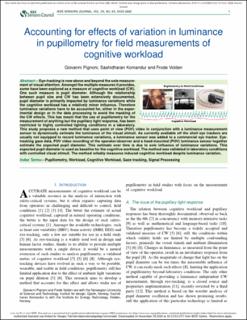| dc.description.abstract | Eye-tracking is now above and beyond the sole measurement of visual attention. Amongst the multiple measures it provides, some have been explored as a measure of cognitive workload (CW). One such measure is pupil diameter. Although the relationship between pupil size and CW has been extensively documented, pupil diameter is primarily impacted by luminance variations while the cognitive workload has a relatively minor influence. Therefore luminance variations have to be accounted for, either in the experimental design or in the data processing to avoid the masking of the CW effects. This has meant that the use of pupillometry for the measurement of anything but the pupillary light response, has been restricted to highly controlled lighting conditions in a laboratory. This study proposes a new method that uses point of view (POV) video in conjunction with a luminance measurement sensor to dynamically estimate the luminance of the visual stimuli. As currently available off the shelf eye trackers are usually not equipped to record luminance variations, a luminance sensor was added to a commercial eye tracker. Eye-tracking gaze data, POV video recording of the operator/observer and a head-mounted (POV) luminance sensor together estimate the expected pupil diameter. This estimate over time is due to sole influence of luminance variations. This expected pupil diameter is used as baseline for the cognitive workload. The method was validated in laboratory conditions with controlled visual stimuli. The method reliably measures induced cognitive workload despite luminance variation. | en_US |
